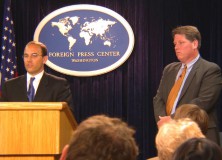Countering Terrorist Financing — Christopher J. Lamb with Alexandra A. Singer

INTRODUCTION:
The attacks of September 11, 2001 illustrated the terrible costs of a decade of weak U.S. government (USG) strategies for combating terrorism and terrorist finance. However, the attacks also galvanized the USG into initiating sweeping reforms to establish a more cohesive structure of cooperation between intelligence and law enforcement agencies. Additionally, Washington enacted new laws and policies to broaden the authority of government agencies to attack terrorist organizations’ financial infrastructures and resources. The initial USG goal was, “starving the terrorists of funding and shutting down the institutions that support, or facilitate terrorism.” However, despite initial successes, the financial structures that underpin terrorism have not yet been “starved” of money, leading many U.S. policy makers to question whether the prevailing strategy of “freezing the money” is the correct one.
STRATEGY:
Prior to 9/11, in law and in strategic paradigms, the USG viewed the threat of terrorism as either a state-sponsored activity that did not constitute a direct threat to national security, or as a crime. To obstruct terrorist financing, legislation focused on freezing terrorist finances and prosecuting individuals for material support of terrorist acts. Various agencies charged with domestic and international law enforcement and intelligence collection prioritized preventing terrorist operations with sometimes peripheral emphasis on how terrorists raised money to carry out activities. In the aftermath of 9/11, the USG employed new laws, resources, and institutional mechanisms to counter the financing of terror. Immediately after 9/11, the “freeze the money” approach persisted as the mainstay of strategy with less attention given to following the money. Though effective against foreign government attempts to sponsor terrorism, this strategy has provided very little insight into sub-state actors’ and foreign terrorist organizations’ fundraising mechanisms. Recently, there has been a more balanced strategic approach between freezing and following the money.
INTEGRATED ELEMENTS OF NATIONAL POWER:
There was a general lack of cooperation prior to 9/11 among the USG agencies that engaged in the fight against terrorist financing. Information collection was scattered, unorganized, and inconsistently carried out. Constant infighting between the Treasury Department, the Federal Bureau of Investigation (FBI), the Central Intelligence Agency (CIA), and the Department of Justice (DOJ) impeded efforts to achieve effective integration. The Treasury Department and CIA also exhibited reluctance to contribute personnel to the Foreign Terrorist Asset Tracking Center (FTATC). After 9/11, interagency cooperation improved substantially. Within concerned agencies, new units were established to ensure that terrorist financing is given proper emphasis and that long-term intelligence collection and analysis is taking place. In cases where operational overlap occurred before 9/11, largely effective remedies were implemented to ensure USG resources would not be wasted. Still, there has been conflict between agencies over the “freeze the money” versus the “follow the money” approach. Those agencies with specialities in finance often side with the “freeze the money” strategy as it provides not only quantifiable results, but is also high profile. Other agencies, like the FBI and CIA, focus more on following the money, using that information to track and kill terrorists.
EVALUATION:
The USG agencies that are capable of collecting financial intelligence lack a single, over-arching entity to direct and coordinate their actions. The extent to which the National Counterterrorism Center may effectively assume this role, is not yet known. The government’s emphasis on investigating terrorism finance has increased markedly. However, it remains unclear which agency is best suited to spearhead counterterrorist financing efforts. In addition, many agencies still gather and horde intelligence, distributing it on a “need-to-know” basis. Though cooperation has improved, deficient architectures still exist to stymie the flow of information and/or impede it from flowing efficiently. Lastly, although the strategy of the USG has evolved, it is still unclear whether freezing or following the money will be the focus of U.S. efforts.
RESULTS:
Information gathering pre-9/11 was scattered, unorganized, and inconsistent. Interagency cooperation was weak and riddled with infighting. This dynamic left groups such as al Qaeda with an operational edge against U.S. counterterrorism efforts. Post-9/11, over-reliance on freezing the money initially cost the USG valuable time in its efforts to understand and uncover terrorist financing methods. Excessive designations, freezes, and seizures without clear evidence resulted in many government actions being overturned in court, damaging what was hailed as a first strike against terrorism. Court reversals hurt USG credibility and its capacity to receive assistance from other nations. Significant legislation has been passed since 9/11 expanding the powers of government agencies so that they can better frustrate terrorists’ use of the global financial system. At the same time, with information regarding USG methods and successes widely available, post-9/11 actions are thought to have spurred the evolution of terrorists’ fundraising towards informal value transfer systems which are more difficult to undermine.
CONCLUSION:
In the fight against terrorist finance, there is improved synergy between U.S. government agencies. Efforts like Operation Green Quest, the Foreign Terrorist Asset Targeting Group, and the Financial Review Group have improved financial intelligence sharing. As a result of new financial intelligence units within USG agencies, a financial angle is targeted in almost every terrorist investigation. However, no overarching authority exists today to ensure efficient pursuit of counterterrorist financing strategy.